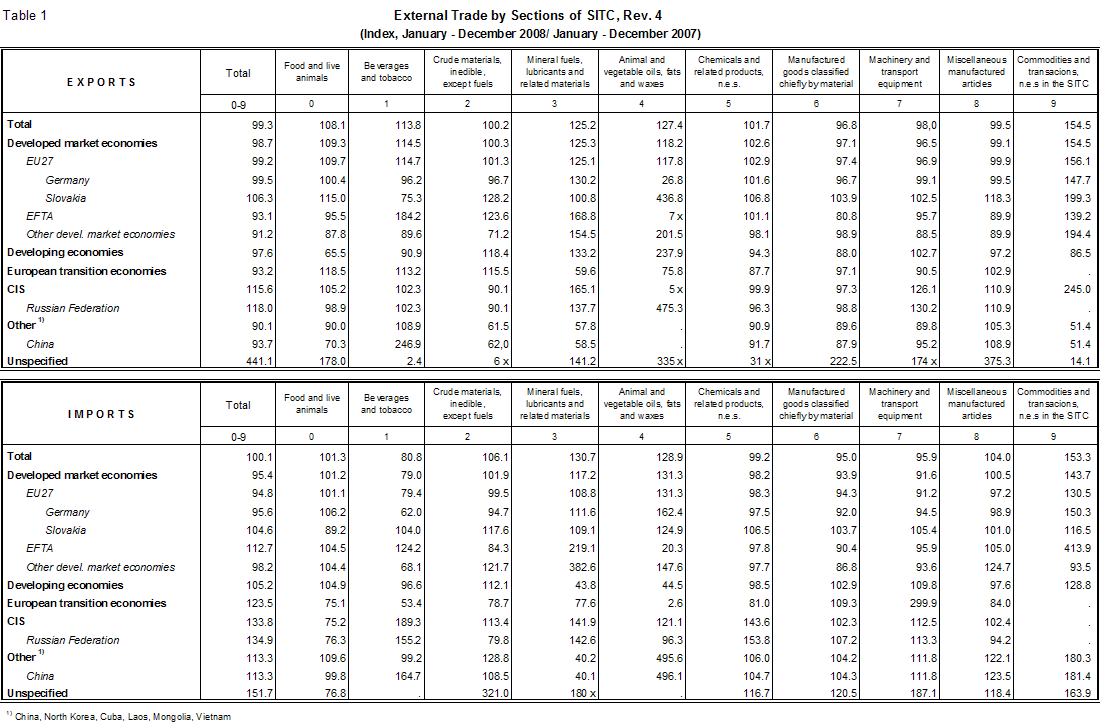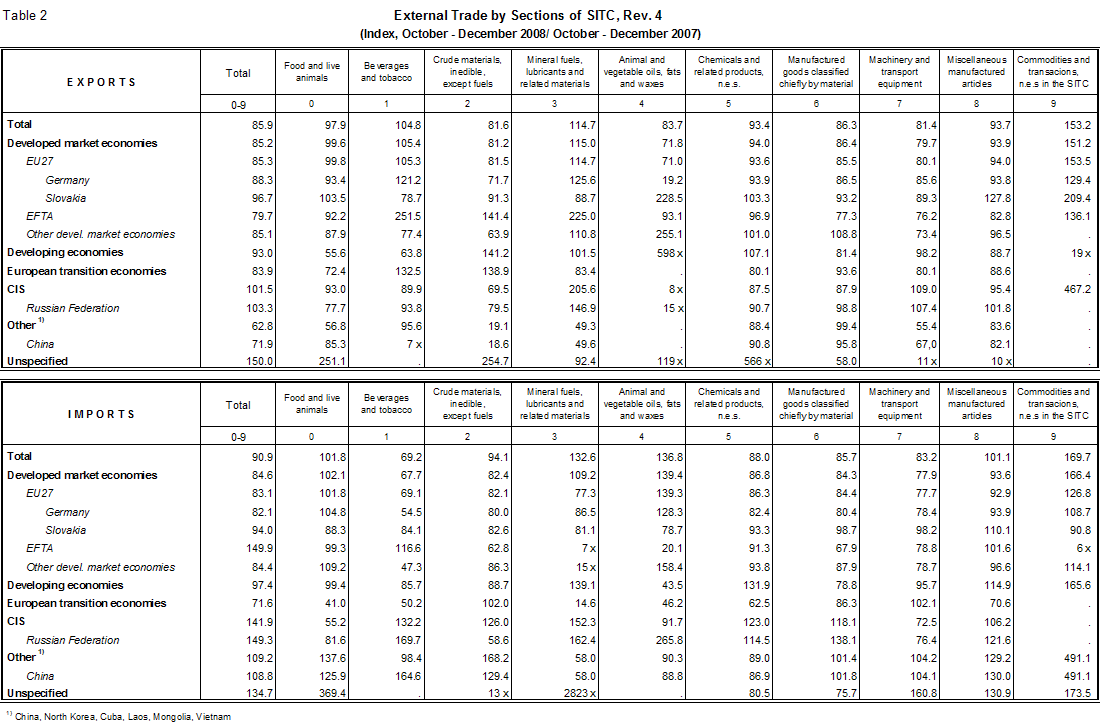External trade - 4. quarter of 2008
Product Code: e-6032-08
In the year 2008 external trade 1 turnover decreased year-on-year for the first time from the day the Czech Republic joined the European Union and for the second time 2 in the history of the Czech Republic. In comparison to 2007, external trade turnover dropped by 0.3% (in 2007 turnover grew by 14.6% on 2006) due to a year-on-year fall in exports (imports were close to stagnation). The external trade balance reached the second highest surplus (yet by CZK 18.5 billion lower compared to 2007) in the history of the Czech Republic.
In 2008 compared to 2007:
- exports decreased by 0.7% and reached CZK 2 463.1 billion, imports grew by 0.1% and reached CZK 2 393.7 billion. Behind these figures are various trends in individual quarters. The growth rates of exports and imports achieved in Q1 2008 decelerated in Q2 and started to decrease y-o-y in Q3. This decrease grew considerably in Q4 ( exports -14.1%, imports -9.1% year-on-year). The lower trade turnover in 2008 compared to 2007 by CZK 13.7 billion was caused only by a fall of CZK 16.1 billion in exports, for imports grew by 2.4 billion. In consequence of appreciation of CZK against EUR and even more against USD, exports and imports in EUR and USD grew – exports and imports in EUR by 10.6% and 11.3% respectively, exports and imports in USD by 18.8% and 19.4% respectively. Due to a moderate appreciation of CZK against EUR and depreciation against USD, exports and imports in these currencies fell y-o-y in Q4 2008 – exports and imports in EUR by 8.7% and 3.6% respectively, exports and imports in USD by 17.2% and 12.4% respectively 3 ;
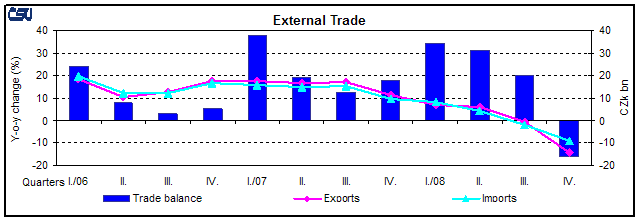
- trade balance surplus, which decreased by CZK 18.5 billion and reached CZK 69.4 billion (the rate of coverage of imports by exports was 102.9% in comparison to 103.7% in 2007), was a result of active trade balance (albeit decreasing) in Q1–Q3 and passive trade balance in Q4 (exports covering 97.2% of imports). By group of countries, trade surplus with EU27 countries rose by CZK 71.1 billion (down by CZK 6.6 billion y-o-y in Q4) and trade deficit with non-EU27 countries increased by CZK 89.6 billion (up by CZK 27.5 billion in Q4). Trade surplus with the European transition economies decreased by CZK 3.3 billion and with EFTA states by CZK 8.2 billion. Trade deficit deteriorated with the CIS 4 countries (by CZK 38.9 billion), other states 5 (by CZK 26.8 billion), other developed market economies (by CZK 5.3 billion) and developing economies (by CZK 9.1 billion). By commodity section, trade surplus rose in ‘machinery and transport equipment’ (by CZK 15.5 billion) and ‘manufactured goods classified chiefly by material’ (by CZK 8.9 billion). Trade deficit improved in ‘agricultural and food crude materials and products‘ (by CZK 9.0 billion) and ‘chemicals and chemical products’ (by CZK 4.3 billion). Trade deficit grew in ‘crude materials, inedible, and mineral fuels’ (by CZK 45.2 billion) and surplus decreased in ‘miscellaneous manufactured articles’ (by CZK 11.1 billion);
- by group of countries, the share of EU27 countries in total exports slightly dropped (from 85.3% to 85.1%), and in total imports decreased more (from 70.8% to 67.0%). A higher share in total exports was registered only for CIS countries (from 3.7% to 4.3%), while the shares of the remaining groups of countries either decreased (EFTA states, other developed market economies and European transition economies) or did not change (developing economies and other states). In total imports, the shares grew of CIS countries (from 6.6% to 8.8%), other states (from 7.9% to 9.0%), developing economies and ETˇFTA states; the low share of European transition economies (0.3%) remained at the 20O7 level and the share of other developed market economies slightly decreased;
- by commodity section, in total exports, shares decreased of ‘machinery and transport equipment’ (from 54.2% to 53.5%) and ‘manufactured goods classified chiefly by material’ (from 20.2% to 19.7%), shares grew of ‘agricultural and food crude materials and products‘ and especially of ‘crude materials, inedible, and mineral fuels’. In total imports, shares dropped of ‘machinery and transport equipment’ (from 43.0% to 41.2%), ‘manufactured goods classified chiefly by material’ (from 20.9% to 19.8%) and ‘chemicals and related products’. ‘Miscellaneous manufactured articles’ and especially ‘crude materials, inedible, and mineral fuels’ (from 10.4% to 13.0%) raised their shares in total imports, the share of ‘agricultural and food crude materials and products‘ remained at the 2007 level.
The main impacts on external trade in 2008 were:
- a fall in industrial production, hitting nearly all the manufacturing industries, especially ‘manufacture of transport vehicles’, apparent mainly in Q4. The decrease in manufacturing industries 6 had a negative impact on total exports, for manufacturing exports are prevailing in total exports (96.1% in 2008). In comparison to 2007, manufacturing exports dropped by 0.7% (CZK -16.6 billion), of which by 14.7% (CZK ‑92.4 billion) in Q4.
The most important shares in manufacturing exports in 2008 had ‘machinery and transport equipment’, especially ‘road vehicles’ (15.6%), ‘electrical machinery, apparatus and appliances, n.e.s.’ (9.1%), ‘office machines and automatic data-processing machines’ (7.0%), ‘general industrial machinery and equipment’ (6.8%) and ‘telecommunications equipment n.e.s.’ (6.6%). Exports of ‘road vehicles’ (SITC 78) made up 15.6% of total exports in 2008 (16.7% in 2007), of which exports of motor cars (SITC 781) 7.4% (8.3% in 2007) and exports of ‘parts and accessories for motor vehicles’ (SITC 784) 6.9% (as in 2007). While external trade in road vehicles still produced the highest surplus among all SITC classes (CZK 184.6 billion), the surplus was down by CZK 19.6 billion compared to 2007 (surplus in motor cars fell by CZK 24.8 billion and surplus in ‘parts and accessories for motor vehicles’ grew by CZK 4.6 billion). The second largest (CZK 47.0 billion) and by CZK 7.7 billion higher y-o-y surplus in machinery trade (and also in total external trade) was recorded for ‘general industrial machinery and equipment’ (SITC 74). The highest y-o-y increase (from CZK 10.1 billion to CZK 24.9 billion) was registered for surplus in ‘telecommunications equipment n.e.s.’ (SITC 76).
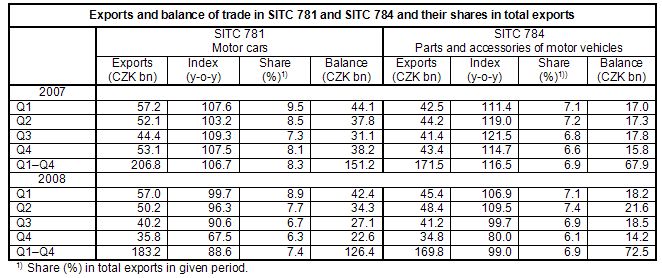

- considerably weakening external demand, especially in the second half of 2008, due to upcoming global financial and economic crisis, which hit the US, Japan and the European Union as well. The EU27 economic growth slowed down already in Q2 2008, as EU27 GDP increased by 1.7% y-o-y, while it grew by 2.3% y-o-y in Q1. In Q3 2008 the economic growth continued weakening more heavily – the EU27 economy rose by only 0.8% 7 y-o-y. Some of the EU27 countries reported y-o-y GDP decreases. Economic situation of EU27 countries deteriorated especially in Q4 2008. According to the Economic Commission’s estimate of 19 January 2008, EU27 GDP slowed down from 3% in 2007 to 1% in 2008. Unfavourable economic development in EU27 countries and related fall in demand had a marked impact on the external trade of the Czech Republic. Deteriorated external conditions in 2008 resulted in a y-o-y decrease of exports to EU27 countries by CZK 17.1 billion (nearly CZK -82 billion in Q4). Exports to the Czech Republic’s main trading partner – Germany (30.8% of total exports) fell as well, namely by CZK 3.5 billion y-o-y (CZK 23.0 billion in Q4).
- unfavourable terms of trade 8 . The movement of external trade prices was affected by world market prices 9 and by exchange rates of CZK against EUR and USD. In January–November 2008, as against January–November 2007, export and import prices were down by 5.1% and 3.4% respectively on average. Terms of trade reached 98.2. In the same period exports and imports increased by 0.3% and 0.8% respectively at current prices and by 6.2% and 5.1% respectively at constant prices. In January–November 2008 the prices reduced current price exports by nearly CZK 139 billion and current price imports by over CZK 99 billion. External trade surplus at constant prices was by approx. CZK 40 billion higher than external trade surplus at current prices.
A closer look at external trade in 2008 by group of countries shows that y-o-y:
- exports decreased to all groups of countries, except CIS countries where exports grew by 15.6%. Exports to EU27 countries dropped by 0.8%. The largest y-o-y decrease, strongly affected by fall in Q4, was observed in exports to other states (-9.9%), followed by exports to other developed market economies, European transition economies, EFTA states and developing economies (see Table 1 and Table 2). Exports to EU27 countries reflected different rates of exports to individual EU27 countries. Only exports to eight EU27 countries grew – e.g. exports to Slovakia (+6.3%), Poland (+8.0%), Romania (+13.4%) and Austria (+2.9%). Exports to the other EU27 countries recorded decreases, which were most marked in exports to Spain, the United Kingdom, Hungary, Belgium and Italy. The highest value increases were recorded for exports to Slovakia (CZK +13.5 billion) and Poland (CZK +11.8 billion); the largest decreases for exports to Spain (CZK -9.3 billion), the United Kingdom (CZK -8.2 billion), Hungary (CZK -7.9 billion) and Italy (CZK ‑6.9 billion). Among the non-EU countries, exports to the Russian Federation (+18.0%, CZK +10.4 billion) grew significantly, the largest fall was registered for exports to the US (-9.8%, CZK -4.7 billion);
- imports from all groups of countries increased, except imports from EU27 countries and other developed market economies. Highly above-the-average increases were recorded for imports from CIS countries, other countries and EFTA states. Imports from non-EU27 countries grew by CZK 90.6 billion. Imports from EU27 countries fell by 5.2% (CZK -88.2 billion). Imports from six EU27 countries grew more than the average – e.g. from Slovakia, Poland and Romania (CZK +9.3 billion in total). Imports from all the other EU27 countries fell. The largest decreases were recorded for imports from Germany (CZK -29.5 billion), the Netherlands (CZK ‑19.2 billion), France (CZK – 12.4 billion), the United Kingdom (CZK -7.3 billion) and Italy (CZK -6.2 billion). Among the non-EU27 countries, mainly imports from the Russian Federation (CZK +39.8 billion), China (CZK +24.7 billion) and Norway (CZK +5.5 billion) grew; the largest decrease was recorded for imports from the US (CZK -4.2 billion);
- external trade surplus fell by CZK 18.5 billion. Trade surplus with EU27 countries reached CZK 491.7 billion, trade deficit with non-EU27 countries CZK 422.3 billion. The latter was due to the trade deficit with other states (CZK 200.7 billion), CIS countries (CZK 104.6 billion), other developed market economies (CZK 76.0 billion) and developing economies (CZK 62.1 billion). The total trade gap was cushioned by trade surplus with European transition economies (CZK 16.4 billion) and EFTA states (CZK 4.8 billion).

The trade balance and year-on-year balance increases/decreases (y-o-y changes) with individual groups of countries reflected the situation of external trade balance with the main partner countries. The total trade surplus with EU27 countries was largely affected (CZK 272.5 billion) by active balance with three countries (Germany, Slovakia and the United Kingdom). A large part (CZK 352.9 billion) of the total trade deficit with non-EU27 countries was produced in trade with three countries (China, the Russian Federation and Japan).
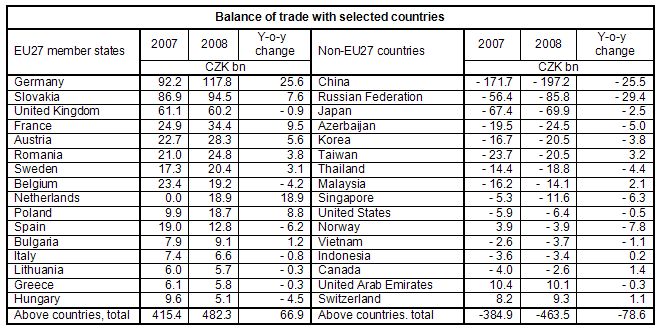
Commodity structure of external trade in 2008, in comparison to 2007, showed lower growth rates of exports and imports in an overwhelming majority of SITC sections. In comparison to 2007, external trade in 2008 was characterised in:
- machinery and transport equipment by decreasing exports and imports. The share of ‘machinery and transport equipment’ dropped in total exports and total imports. Exports of ‘machinery and transport equipment’ fell by 2.0% (CZK -26.8 billion) and imports by 4.1% (CZK -42.4 billion). These export and import decreases were the largest among all SITC sections and had a significant impact on external trade in 2008. Trade surplus in ‘machinery and transport equipment’ reached CZK 330.9 billion compared to CZK 315.4 billion in 2007, of which CZK 462.7 billion made up the trade surplus with EU27 countries (of which CZK 119.3 billion was the trade surplus with Germany). All groups of ‘machinery and transport equipment’ recorded active balance. The highest surplus was produced in trade in ‘road vehicles’ (CZK 184.6 billion, of which CZK 158.1 billion with EU27 countries), followed by ‘general industrial machinery and equipment’ (CZK 47.0 billion, of which CZK 37.0 billion with EU27 countries), ‘telecommunications and sound-recording equipment’ (CZK 24.9 billion, of which CZK 90.8 billion with EU27 countries), ‘office machines and automatic data-processing machines’ (CZK 21.9 billion, of which CZK 104.7 billion with EU27 countries), ‘electrical machinery, apparatus and appliances, n.e.s.’ (CZK 15.3 billion, of which CZK 56.3 billion with EU27 countries), power-generating machinery and equipment’ (CZK 13.2 billion, of which CZK 4.6 billion with EU27 countries), ‘other transport equipment’ (CZK 11.5 billion, of which CZK 4.7 billion with EU27 countries) and ‘machinery specialized for particular industries’ (CZK 10.9 billion, of which CZK 3.3 billion with EU27 countries);
- manufactured goods classified chiefly by material by decreasing exports and imports. The share of these goods dropped in total exports and total imports (from 20.2% to 19.7% and from 20.9% to 19.8% respectively). The trade surplus grew by CZK 8.9 billion in 2008 and reached CZK 9.8 billion (of which CZK 18.4 billion with EU27 countries). This improvement was due to decreases in trade deficit in ‘non-ferrous metals’ (by CZK 11.2 billion) and ‘iron and steel’ (by CZK 1.4 billion). The highest trade surpluses were reached in ‘manufactures of metals’, ‘non-metallic mineral manufactures’ and ‘rubber manufactures, n.e.s.’;
- miscellaneous manufactured articles, commodities and transactions not classified elsewhere in the SITC by a slight decrease of exports and rise in imports, which resulted in a fall of the surplus by CZK 11.2 billion, maintaining their share in total exports (11.0%) and increase in total imports 10.6%). Trade surplus rose insignificantly in ‘prefabricated buildings, sanitary, plumbing, heating and lighting fixtures and fittings, n.e.s.’ (by CZK 0.3 billion) and ‘miscellaneous manufactured articles, n.e.s.’ (by CZK 1.3 billion) and decreased in ‘furniture and parts thereof’ (by CZK 2.3 billion). The trade deficit deteriorated in ‘professional, scientific and controlling instruments and apparatus, n.e.s.‘ (by CZK 2.4 billion), ‘articles of apparel and clothing accessories’ (by CZK 4.5 billion) and ‘footwear’ (by CZK 1.6 billion);
- chemicals and related products by a slight increase in exports and fall in imports and thus by the strengthening of their share in total exports (5.9%) and weakening share in total imports (10.3%). The trade deficit was the second highest (CZK 100.0 billion) and improved by CZK 4.3 billion y-o-y. A large deficit remained in ‘medicinal and pharmaceutical products’ that rose by CZK 2.5 billion y-o-y. Deficit fell in trade in ‘plastics in primary forms’ (by CZK 4.4 billion) and ‘plastics in non-primary forms’ (by CZK 3.6 billion), slightly grew in ‘chemical materials and products, n.e.s.’ and ‘inorganic chemicals’ and significantly grew in ‘fertilisers’ (from CZK 1.4 billion to CZK 3.8 billion);
- crude materials, inedible, and mineral fuels by the highest percentage growth of exports and even more of imports, which contributed to an increase in the share of these products in total exports and especially in total imports (from 5.3% to 6.0% and from 10.4% to 13.0% respectively). The trade deficit grew by CZK 45.2 billion and remained the highest among all SITC sections (CZK 162.4 billion). The deficit deteriorated due to higher deficit in trade in ‘petroleum, petroleum products and related materials’ by CZK 19.3 billion and ‘gas, natural and manufactured’ by CZK 16.5 billion. Imports of these commodity items grew by 23.5% and 43.2% respectively y-o-y (petroleum imports rose by 13.9% in volume and by 43.1% in value; natural gas imports rose by 15.7% in volume and by 45.3% in value). The balance of trade in crude materials, inedible, and mineral fuels was affected by increase in trade surplus in ‘coal, coke and briquettes’ by CZK 4.9 billion and by decreases in trade surplus in ‘electric current’ by CZK 10.8 billion and ‘cork and wood’ by CZK 1.8 billion;
- agricultural and food crude materials and products by increase in exports and fall in imports. The trade deficit fell by CZK 9.0 billion. Trade deficit in ‘vegetables and fruit’ slightly decreased (by CZK 0.8 billion), trade surplus in ‘cereals and cereal preparations’ rose from CZK 3.8 billion to CZK 5.5 billion, trade balance of ‘tobacco and tobacco manufactures’ turned from the CZK 1.8 billion deficit to a CZK 3.6 billion surplus and trade surplus in ‘dairy products and birds eggs’ decreased from CZK 4.4 billion to CZK 3.9 billion.

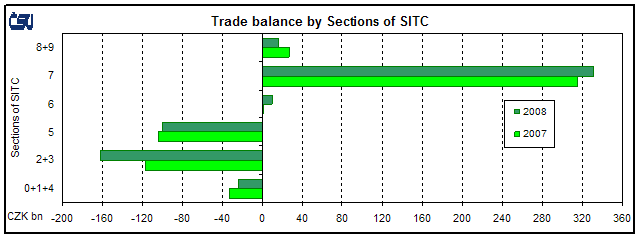
| Sections of SITC, Rev. 4 | Sections of SITC, Rev. 4 | ||
| 0+1+4 | Agricultural and food crude materials and products | 6 | Manufactured goods classified chiefly by material |
| 2+3 | Crude materials, inedible, and mineral fuels | 7 | Machinery and transport equipment |
| 5 | Chemicals and related products | 8+9 | Miscellaneous manufactured articles, commodities and transactions not classified elsewhere in the SITC |
o - o - o
According to Eurostat news release of 16 January 2009 on EU27 external trade in January–October 2008, the rates of EU27 exports and imports slowed down. However, the rate of the Czech Republic’s external trade was still more favourable in comparison to the EU27 and the new EU member states. In January–October 2008, compared to January–October 2007, EU27 (EU15) exports in EUR grew by 5.9% (4.9%) and EU27 (EU15) imports rose by 6.8% (5.7%) on average. In the same period, exports and imports of the new 12 member states grew by 15.2% and 15.3% respectively. The shares of the 12 new member states in total EU27 exports rose to 11.1% (from 10.2% in January–October 2007) and in total EU27 imports grew to 12.5% (from 11.5% in January–October 2007). The EU27 trade balance reached a deficit of EUR 123.8 billion in January–October 2008 (the EU15 trade deficit was EUR 61 billion and the 12 new member states’ deficit EUR 62.8 billion). As one of the nine EU27 countries and one of the two (Czech Republic and Hungary) new member states, the Czech Republic recorded a trade surplus in January–October 2008.
1 All data are at current prices. Data for 2007 are finalised and refer to 28 August 2008 closing date. Data for January–September 2008 are preliminary referring to 1 December 2008; data for October 2008 are preliminary referring to 1 December 2008; data for November 2008 are preliminary referring to 31 December 2008; and data for December 2008 are preliminary referring to 29 January 2009. The data come from the basic units and then rounded, which may give rise to discrepancies.
2 In 2002, compared to 2001, external trade turnover decreased by 2.8% (exports -1.0%, imports -4.3%).
3 In January–December 2008, compared to January–December 2007, CZK strengthened by 11.3% on average against EUR and by 19.2% on average against USD. In Q4 2008, CZK still appreciated by 5.9% on average against EUR and depreciated by 3.7% on average against USD.
4 The Commonwealth of Independent States
5 China, North Korea, Cuba, Laos, Mongolia and Vietnam
6 Items CZ-CPA15 to CZ-CPA36.
7 According to the second estimate of Eurostat for Q3 2008 of 8 January 2009.
8 Export and import price indices in the Czech Republic are published a month later than data on the external trade of the CR.
9 In Q1–Q4 2008, compared to Q1–Q4 2007, world prices of industrial raw materials and food grew by 37.1% in total. For example, world prices of crude oil Brent grew by 35.8%, of natural gas by 55.3% and of food and oils by 25.9%. The yearlong increase of world prices reflected their various trends in individual quarters, especially in Q4 2008. In Q4 2008, compared to Q4 2007, world prices of industrial raw materials rose by only 0.2% in total because, e.g., prices fell of crude oil Brent fell by over a third, of food and oils by 9.8% and of metals by over two fifths, but world prices of natural gas grew by nearly 64% – see the CZSO World Price Indices of Industrial Raw Materials and Food for December 2008.
